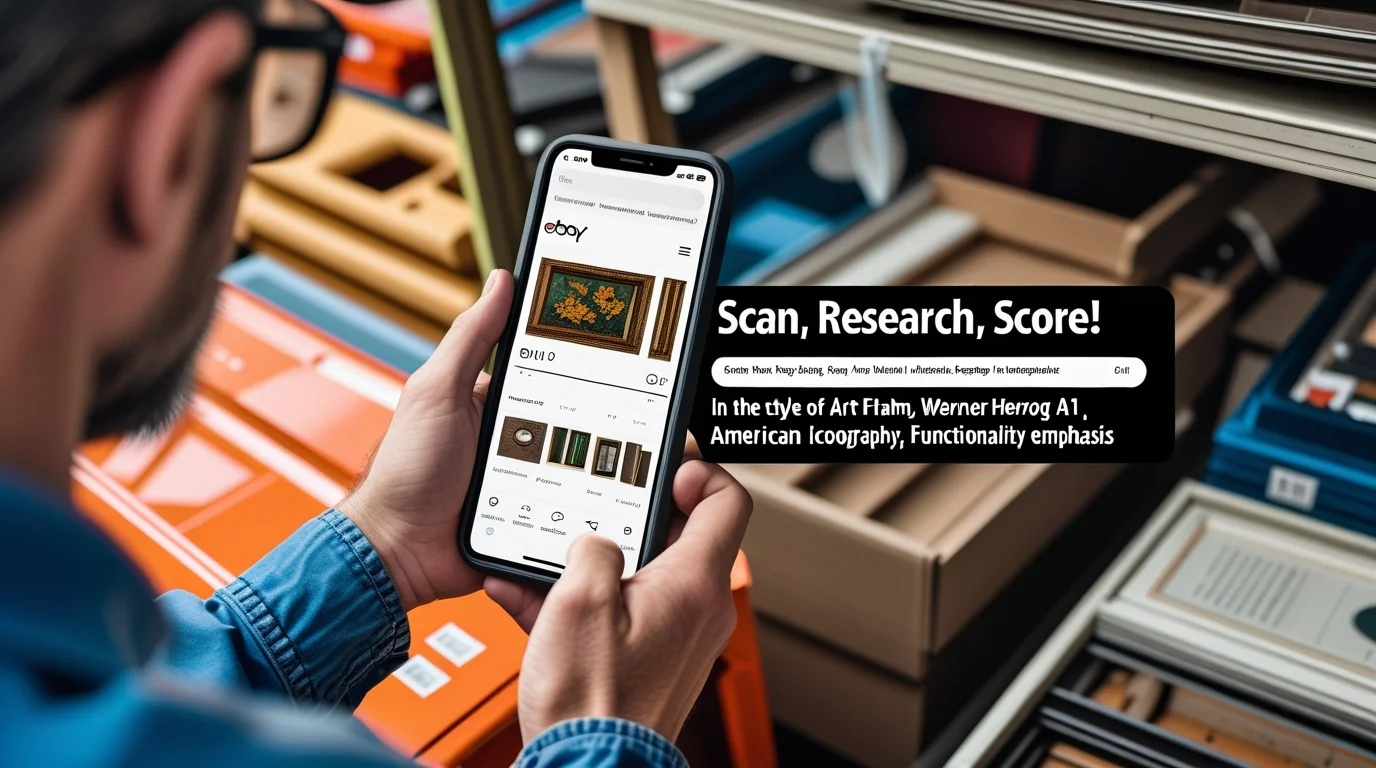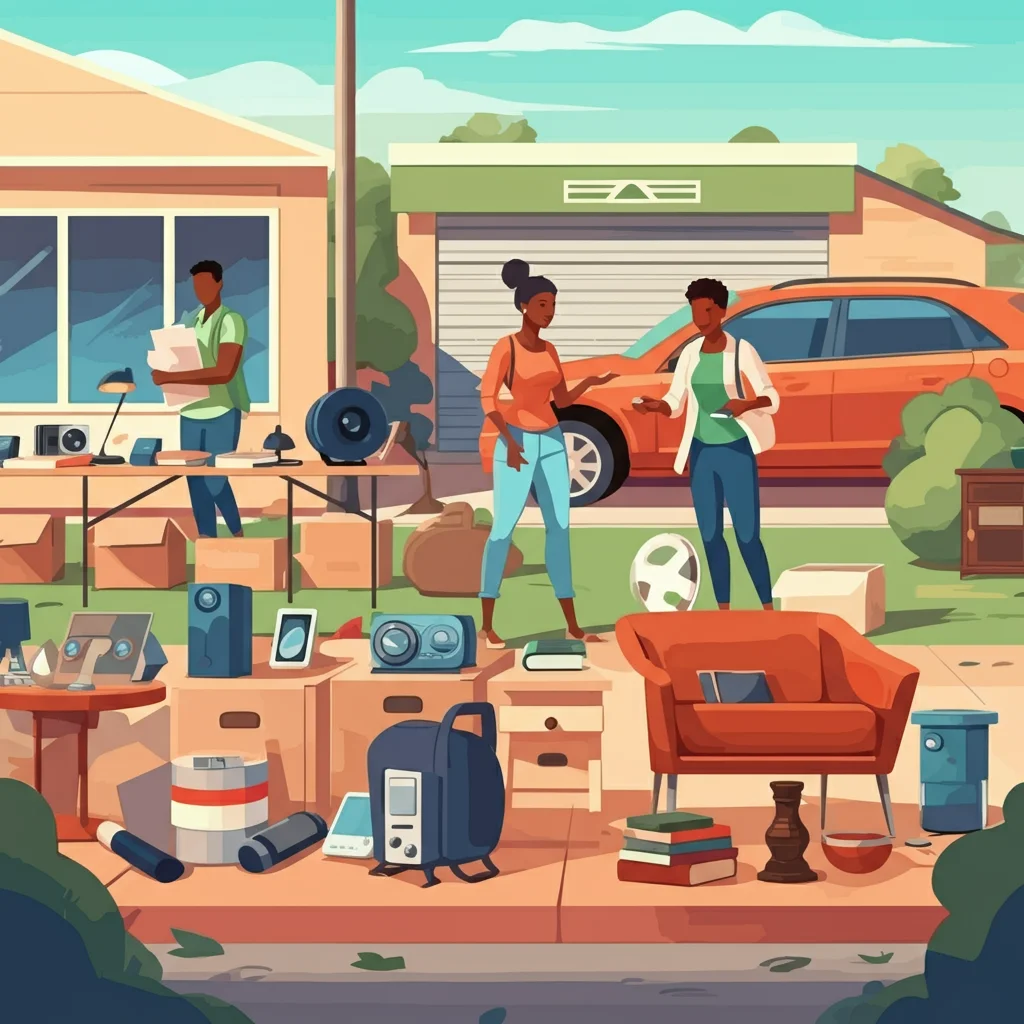Are you seeking a flexible, profitable side hustle that requires minimal upfront investment and taps into a booming secondhand market? Reselling items from garage sales is not only one of the simplest and fastest ways to make extra money from home, but it's also a genuinely fun treasure hunt. With a keen eye, effective negotiation skills, and a strategic approach to online selling, you can transform someone's unwanted items into substantial profits and a consistent passive income stream.
In this comprehensive guide, you’ll learn precisely how to master the art of "buy low, sell high," which specific items are worth flipping, and where to resell for maximum profit in 2025, turning your weekends into profitable ventures.
1. Why Garage Sale Flipping Still Works (and is Booming in 2025)
Garage sales (also known as yard sales, rummage sales, or car boot sales in other regions) are perpetual goldmines for flipping items. They represent a unique corner of the secondhand market where sellers often prioritize quick decluttering and convenience over maximizing their profit on individual items. This creates massive opportunities for savvy resellers.
Here’s why this side hustle remains incredibly effective and is growing in 2025:
Sellers Lack Value Knowledge: Most garage sale hosts are not professional resellers. They simply want to clear out their homes quickly, often pricing items significantly below their actual market value. They don't research prices on eBay or Facebook Marketplace.
On-the-Spot Negotiation: Unlike fixed-price retail, you can directly negotiate prices and often secure incredible bundle deals on multiple items, dramatically increasing your potential profit margins.
Ultra-Low Inventory Cost: Many items can be acquired for just a few dollars, or even free if you ask politely or are offered them as part of a larger purchase. This keeps your upfront investment almost non-existent.
Unique & Vintage Finds: Garage sales are a prime source for unique, vintage items, discontinued models, or collectible goods that hold significant resale value due to their rarity or nostalgia factor.
Booming Secondhand Market: The market for secondhand goods is exploding, driven by platforms like Facebook Marketplace, eBay, Poshmark, and Mercari. Consumers are increasingly conscious of sustainability, affordability, and the desire for unique finds, fueling demand for pre-owned items.
Perfect for Beginners: This hustle requires no special degrees, certifications, or complex tech skills. It's ideal for students, stay-at-home parents, or anyone looking to earn quick money without committing to a full-time online business immediately. It’s also a low-risk entry point into the world of reselling and e-commerce.
2. Best Items to Resell from Garage Sales: Your Treasure Map
Knowing what to look for is half the battle. These categories consistently perform well for reselling online:
Electronics (Working or Fixable):
Look for headphones (Bose, Sony, Beats), cameras (digital, vintage film, Polaroids), game consoles (Nintendo, PlayStation, Xbox—especially older generations or bundles), remote controls (often missing but valuable if original), speakers, and smart home devices.
Why they sell: High demand, good profit margins, and easy to ship smaller items. Vintage or discontinued models often have a niche collector's market.
Books & Media:
Look for box sets (DVD, Blu-ray, classic book series), collectible editions, textbooks (check current editions), vintage vinyl records (especially classic rock, jazz, and rare labels), and CDs (full box sets and rare artists).
Why they sell: High demand for specific titles, easy to ship, low acquisition cost. Check conditions carefully.
Toys & Games:
Look for LEGO sets (sealed or complete sets with minifigures), Hot Wheels/Matchbox cars (vintage or rare models), action figures (Star Wars, Marvel, Transformers—in good condition), board games (sealed or complete with all pieces, especially popular or vintage ones), vintage video games, and consoles.
Why they sell: Nostalgia, collector demand, and parents looking for deals.
Tools & Hardware:
Look for power tools (DeWalt, Makita, Milwaukee, Bosch), hand tools (Snap-on, Craftsman, older sturdy brands), auto tools, and complete toolkits.
Why they sell: High retail price, essential for DIYers and professionals. Brand name recognition equals big markup.
Home Decor & Small Furniture:
Look for lamps (unique designs, mid-century modern), mirrors (large, ornate, or vintage), shelves, bar carts, small accent chairs, and vintage ceramics (mid-century, specific brands).
Why they sell: People constantly refresh their living spaces. Flipping furniture with light touch-ups, a fresh coat of paint, or new hardware can add significant profit.
Collectibles & Memorabilia:
Look for trading cards (Pokémon, Magic: The Gathering, sports cards—check condition and rarity), vintage signs (advertising, metal), sports memorabilia, coins (silver, rare dates), stamps, comic books, and figurines.
Why they sell: Driven by passion and rarity. Requires some knowledge or quick research.
Branded Clothes & Shoes:
Look for Nike, Adidas, Patagonia, Lululemon, Levi’s, Columbia, designer brands, and vintage sportswear. Check for clean, logo-heavy, or limited editions.
Why they sell: People want quality brands at a discount. Look for excellent condition, no stains, rips, or excessive wear.
Vintage Electronics & Appliances (for niche collectors/restorers):
Look for VHS players, boomboxes, rotary phones, Polaroid cameras, record players, and specific vintage kitchen appliances.
Why they sell: Nostalgia, aesthetic appeal, often used as props or for restoration projects. Test functionality if possible.
🚫 Red Flags—Items to Avoid:
Broken or Heavily Damaged Items: Unless you have repair skills and know the profit potential.
Missing Parts: Especially for complex items like electronics or board games, unless the part is easily replaceable and cheap.
Stained or Heavily Worn Clothing/Upholstery: Difficult to clean and resell unless it's a very high-value, rare item that can be professionally restored.
Common, Mass-Produced Items: Unless you can get them for next to nothing and sell them in bulk.
Items that are heavy/bulky to ship: Factor in shipping costs if selling online. Local pickup platforms are better for these.
Untested Electronics: Always ask to plug them in, or assume they are for parts.
3. Where to Sell the Items for Profit: Your Online Marketplaces
Once you've scored some deals, knowing the best platform to flip them for profit is key. Each platform has its strengths:
eBay:
Best for: collectibles, electronics (vintage or niche), vintage items, unique finds, and items that benefit from global reach.
Tips: Focus on detailed descriptions, clear photos from multiple angles, and using relevant keywords in your title. Offer both auction and "Buy It Now" options. Factor in shipping costs carefully.
Best for: Fast local sales, furniture, bulky items, general household goods, and items you don't want to ship.
Tips: Emphasize local pickup, clear photos, quick responses, and be prepared to negotiate. Use Facebook Groups for specific niches (e.g., "Vintage Furniture for Sale [Your City]").
Best for: Brand-name clothes, shoes, accessories, and jewelry.
Tips: Take bright, appealing photos of the item on a hanger or flat lay. Share your listings frequently, engage with other users, and follow popular brands. Shipping is easy with prepaid labels.
Best for: Easy app-based selling for a wide range of goods, including electronics, home goods, toys, and clothing.
Tips: Simple listing process, flexible shipping options, good for items that might not be niche enough for eBay but too specific for Facebook Marketplace.
Best for: Targeting Gen Z for vintage or trendy apparel, unique fashion pieces, streetwear, and Y2K styles. More visually driven, like Instagram.
Tips: Model the clothes, take creative photos, and use relevant hashtags.
Best for: Local reselling for bulkier items, furniture, and larger electronics, similar to Craigslist but with a more modern app interface.
Tips: Emphasize local pickup, clear communication, and meeting in safe, public places.
Pro Tip for ALL Online Selling:
High-Quality Photos: Use good lighting (natural daylight is best), multiple angles, and show any flaws clearly. Blur out messy backgrounds.
Clear, Detailed Descriptions: Include brand, model number, dimensions, condition, any imperfections, and what's included. Use keywords relevant to your item.
Strategic Pricing: List prices slightly above what you're willing to accept to allow for negotiation. Research "sold listings" (not just active listings) on your chosen platform to understand realistic selling prices.
4. How to Spot High-Value Items Quickly: Your Detective Skills

Developing a "flipper's eye" comes with practice, but these tactics will accelerate your learning:
Scan for Brand Names: Your first pass should be a quick scan for well-known brands, especially in electronics (Apple, Sony, Nintendo), apparel (Patagonia, Lululemon, Nike), tools (DeWalt, Milwaukee), and collectibles (LEGO, specific toy lines). Familiarize yourself with brands that hold value.
Look for Sealed or Like-New Items: These command a higher price. Original packaging, tags, or unopened boxes are huge indicators of value.
Check Condition Meticulously:
Electronics: Are all cables included? Any major scratches? Test functionality if possible.
Clothing: Check for stains, rips, missing buttons, or excessive pilling. Hold it up to the light. Do a "smell test"—avoid smoke or pet odors unless it's a very rare item that can be professionally cleaned.
Furniture: Check for wobbles, deep gouges, water stains, or pest damage.
Toys/Games: Are all pieces present? Are instructions included?
Use Your Phone for Real-Time Price Checks: This is your secret weapon. Open the eBay app and search for the item. Filter results by "Sold Listings" to see what the item has actually sold for recently, not just what people are asking. This gives you concrete data for negotiation.
Don't Be Afraid to Ask: Engage the seller. "Does this [electronic item] work?" "Is this [game] complete?" "What's your best price on this [item]?"
Ask for Bundle Deals: Once you've identified a few items, politely ask, "If I take these three things, would you be willing to do [your desired price]?" This often works, as sellers prefer fewer items to pack up.
Every garage sale you attend will sharpen your eyes and intuition. The more you practice, the faster you'll identify those profitable gems.
5. Tips for Buying Smarter at Garage Sales: Optimize Your Hunt
Being prepared and employing smart strategies will significantly improve your success rate flipping items.
Go Early: The early bird gets the worm! Garage sales often have their best inventory in the first hour. Arrive shortly after the advertised start time (or even a little before, if allowed) to get first pick of the truly valuable items.
Carry Cash in Small Bills: Sellers often prefer cash, and having exact change or small denominations makes for quicker, smoother transactions and easier negotiations.
Be Polite, Friendly, and Respectful: A good attitude goes a long way when negotiating prices. A friendly demeanor can open doors to better deals and even lead to sellers offering you other unlisted items.
Bring Bags or Boxes: Have your own reusable shopping bags, sturdy totes, or even a collapsible wagon for hauling your finds back to your car.
Set a Daily Spending Limit: Decide how much you're willing to invest before you leave home. This helps you stay disciplined and ensures you remain profitable.
Optional Tools to Enhance Your Hunt:
Mini Flashlight: For inspecting electronics, checking inside dark boxes, or examining items in dimly lit garages.
Portable Phone Charger: Crucial for continuous eBay sold listings research.
Price Scanner Apps (e.g., Scoutly for books or general barcode scanners): Quickly check prices on books, DVDs, and other barcoded items.
Measuring Tape: Useful for furniture or items that might need to fit specific spaces.
Gloves: If you're sifting through dusty boxes.
6. How Much Can You Make? Realizing Your Passive Income Potential
The profit potential from garage sale flipping is surprisingly robust and scalable. Your earnings will vary based on your eye for value, negotiation skills, and consistency.
Here’s a realistic breakdown of typical profits per item:
Small Flips (books, small toys, basic kitchenware): Expect to make $5–$15 profit each. (Buy for $1-2, sell for $10-20).
Mid-Tier Flips (tools, branded clothing, home decor, small electronics): These typically yield $20–$50 profit per item. (Buy for $5-15, sell for $30-70).
Big Flips (furniture, high-end electronics, valuable collectibles, large LEGO sets): This is where you can see $75–$200+ profit per item. (Buy for $10-50, sell for $100-250+).
Income Potential:
A single productive Saturday morning hitting a few garage sales could easily turn an initial investment of $50 into $300+ in profit, depending on what treasures you unearth.
If you consistently dedicate just a few hours a week to sourcing and listing, this can easily become a $500–$1,000+/month side hustle. As you gain experience, refine your niche, and optimize your selling process, it has the potential to grow into a substantial online business that generates significant passive income. Many full-time resellers started exactly this way.
Important Note: Remember to track your purchases and sales to accurately calculate your profits and for potential tax purposes.
7. Bonus: Build a Small Brand Around It— Scale Your Influence and Income
Once you get the hang of garage sale flipping and start consistently earning money, consider scaling your efforts by building a small brand around your expertise. This can open up additional passive income streams and opportunities.
Start an Instagram or YouTube channel: document your finds, share your before-and-after transformations, provide tips on spotting deals, and reveal your profit margins. Content creation can become another revenue stream through ads, sponsorships, or even selling a digital product (like a guide to garage sale flipping).
Build a Niche eBay or Etsy Store: Instead of just selling individual items, create a curated online store on eBay for specific niches (e.g., "Vintage Electronics Emporium") or on Etsy for truly unique vintage items or upcycled furniture. This builds customer loyalty and repeat business.
Create a Blog or Newsletter: Share your experiences, best finds, and detailed guides on "thrift flipping." This can attract an audience, generate ad revenue, or serve as a platform to promote your own digital products or courses.
Partner with Local Sellers for Commission Flips: Offer your reselling expertise to others who want to declutter but don't have the time or knowledge to sell. You can take their items on consignment and split the profits.
Host Local Pop-Ups or Booths: Once you have a sizable inventory, consider renting a booth at a local flea market, antique mall, or craft fair to reach a different audience.
Offer "personal shopping" services: Some individuals might pay you to find specific vintage items or collectibles for them.
Final Thoughts: Your Next Weekend Adventure Awaits
Reselling items from garage sales is truly one of the easiest, most enjoyable, and most profitable side hustles you can start in 2025. It’s perfect for individuals who enjoy the thrill of the treasure hunt, have a knack for identifying hidden value, and are motivated to flip items for profit.
You don’t need significant capital, extensive prior experience, or advanced tech skills to begin. All you need is motivation, curiosity, and a willingness to explore the possibilities of the secondhand market.
So, grab your phone, organize your Saturday morning, and head out to those neighborhood sales. You're just a few keen observations and smart negotiations away from transforming someone's old items into your new online income stream. Your journey to passive income starts with that first flip!



